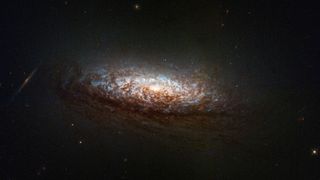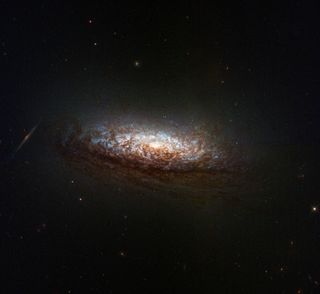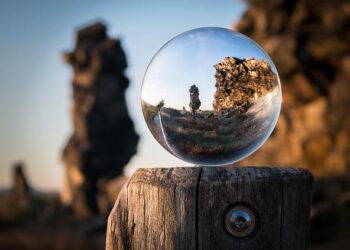
(Image credit: NASA/ESA/STScI/David Thilker (JHU))
The Hubble Space Telescope is back in action, having returned to science operations but now with just one operating gyroscope. And to prove it’s still got what it takes, the venerable observatory snapped a striking photo of the dusty spiral galaxy NGC 1546.
Located about 50 million light-years away in the constellation of Dorado, the Swordfish, NGC 1546 is a brilliant example of what’s referred to as a “flocculent” spiral. Rather than the graceful sweep of curved arms that some spiral galaxies have, NGC 1546’s appear more messy, with eruptions of star formation in the arms triggering more star formation nearby, leading to the patchy structure.
The dust that we see backlit by NGC 1546’s bright core is the product of countless generations of stars that have been born, lived and died, ejecting vast amounts of dust into space during their death throes. The dust, made from particles just microns (millionths of a meter) in size, shows that the galaxy has a healthy chemistry; that dust will be recycled into new generations of stars and provide the heavy elements for planets around those new stars. The bright blue regions, more visible on the far side of the galaxy where dust isn’t blocking the view, are examples of these hot young stars in freshly born star clusters.
Although the Hubble Space Telescope has taken many spectacular images such as this during its 34 years of operation in Earth orbit, this image of NGC 1546 taken with the telescope’s Wide-field Camera 3 is one of Hubble’s most important. That’s because it puts to rest any doubts about Hubble’s immediate future.
Related: The Hubble Space Telescope is old. Here’s NASA’s new plan to keep it alive through 2035

A full version of the flocculent spiral galaxy NGC 1546, imaged by the Hubble Space Telescope. On the left is another galaxy, and edge-on disk galaxy in the background. (Image credit: NASA/ESA/STScI/David Thilker (JHU))
Over the past year, the space telescope repeatedly entered safe mode as one of its last three functional gyroscopes began returning faulty data. Hubble was equipped with six new gyroscopes, which are used for slewing and pointing the telescope, during the last servicing mission in 2009. Fifteen years later, only two remain fully operational. While three working gyroscopes at any one time is preferred for efficiency reasons, Hubble can function on just one. This has even been tested, in 2008, when its previous set of gyroscopes all broke down. With two remaining gyroscopes and no hope for another servicing mission (the space shuttle retired in 2011), Hubble has to function on just one, with the remaining gyroscope kept as backup should this one fail.
This isn’t the perfect solution: While Hubble can still point anywhere on the celestial sphere, its mobility is more limited with a slower slewing and target-locking speed, meaning that the area it can observe at any one time is reduced. Furthermore, it won’t be able to follow any asteroids or comets interior to the orbit of Mars, because they move too fast for a single gyroscope to keep up. Overall, NASA estimates that from hereon Hubble will see a drop of up to 25% in productivity.
Breaking space news, the latest updates on rocket launches, skywatching events and more!
Hubble returned to active duty on June 14, with this image of NGC 1546 being its first since then — and the first of many more to come.
“Hubble’s new image of a spectacular galaxy demonstrates the full success of our new, more stable pointing mode for the telescope,” Jennifer Wiseman, the senior project scientist for Hubble at NASA’s Goddard Space Flight Center in Maryland, said in a statement. “We’re poised now for many years of discovery ahead, and we’ll be looking at everything from our solar system to exoplanets to distant galaxies. Hubble plays a powerful role in NASA’s astronomical toolkit.”
Over the years, the Hubble Space Telescope has overcome many challenges, from a wrongly polished primary mirror requiring the insertion of corrective lenses in a do-or-die rescue mission, to multiple failing instruments that have needed to be replaced, and the wear and tear of a spacecraft now in its fourth decade in space. And yet, despite everything, Hubble is surviving and thriving. Here’s to many more years of this fantastic observatory producing breathtaking views of the cosmos.
Join our Space Forums to keep talking space on the latest missions, night sky and more! And if you have a news tip, correction or comment, let us know at: [email protected].
Keith Cooper is a freelance science journalist and editor in the United Kingdom, and has a degree in physics and astrophysics from the University of Manchester. He’s the author of “The Contact Paradox: Challenging Our Assumptions in the Search for Extraterrestrial Intelligence” (Bloomsbury Sigma, 2020) and has written articles on astronomy, space, physics and astrobiology for a multitude of magazines and websites.
>>> Read full article>>>
Copyright for syndicated content belongs to the linked Source : Space.com – https://www.space.com/hubble-space-telescope-one-gyroscope-galaxy-photo































